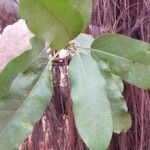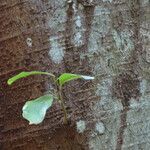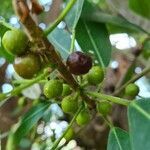Ramulis junioribus sparse pilosis mox glabris, in sicco anguloso-sulcatis; petiolis longissimis tenuibus glabris, apice vix incrassato-articulatis, foliis membranaceis oblongo-obovatis apice apiculatis basi sensim cuneatim attenuatis, utrinque in sicco laete viridibus, costa subtus prominente, venis utrinque c. 9 patulis vix curvatis subtus prominentibus supra vix distinctis ad marginem commissura subarcuate conjunctis; nervis tertiariis subtus prominulis reticulatis. Receptaculis pisiformibus sessilibus glabris luteis in sicco vix distincter albido-maculatis bracteis minimis appressis velutinis, ostiolo subimpresso. Die Rinde der jungen Zweige ist hellrötlichbraun mit etwas seidigem Glanze. Die Blattstiele sind 4-5 cm lang, 2/3 mm breit, am oberen Gelenk auf der Rückseite mit einem glänzenden Drüsenfleck. Das Blatt ist 7-9 cm lang, 3-4 cm breit, die grösste Breite liegt weit oberhalb der Mitte, in etwa 3/4 der Blatthöhe. Die Früchte sind 7 mm lang und 8 mm breit, die Bracteen haben zusammen 1-1 1/2 mm im Durchmesser, die Blütenhüllzipfel sind ziemlich stumpf.
Leaves spirally arranged, occasionally subopposite; lamina elliptic to oblanceolate or subobovate to subovate, (1.5)3–12(18) x (1)1.5–6(9) cm., subcoriaceous; apex acuminate to obtuse or rounded; base cuneate to rounded or subcordate, often slightly inaequilateral; margin entire; superior surface glabrous or sparsely puberulous to pubescent, the midrib more densely so, the inferior surface glabrous or sparsely to densely white-to brownish-puberulous or pubescent on the whole surface, the main veins or only the midrib; lateral veins (5)7–12(16) pairs, midrib often reaching the apex of the lamina (even in leaves with a rounded apex), tertiary venation reticulate or parallel to the lateral veins; petiole (0.5)1–4(6) cm. long, 1–2 mm. thick, often (not depending on the size of the lamina or the position of the leaf on the twig) variable in length on the same twig, glabrous or puberulous, hirtellous or pubescent; stipules 3–10(20) mm. long, white to brown pubescent, puberulous or only ciliolate, caducous or subpersistent.
A fig. It is a tree which can lose its leaves during the dry season of the year. It is often a strangler fig on oil palm. It grows up to 12-25 m high. It can grow in soil or attached to other plants. It can be a climber. It can have buttresses or have several stems. The crown is dark and rounded and spreading. The bark is smooth and grey. The leafy twigs are 2-8 mm thick. The leaves are arranged in spirals. The leaves vary. They are often oval. The leaves are 3-12 cm long by 2-6 cm wide. There are 7-12 pairs of side veins. The young leaves are pale and hairy underneath. The fig fruit are about 1 cm across. The fruit often occur in pairs in the axils of the leaves. They become purple-red when ripe.
Receptacle globose to ellipsoid, c. 5–10(12) mm. in diam. when fresh, 4–12(17) mm. in diam. when dry, glabrous or sparsely to densely white to brown puberulous or pubescent, reddish, yellowish or brownish at maturity; wall thin, mostly smooth or slightly wrinkled when dry; apex plane to strongly protruding when dry.
Leafy twigs 1.5–8 mm. thick, minutely puberulous to hirtellous or white-to brown-pubescent, or glabrous on the stipule scars, sometimes entirely glabrous, periderm usually not flaking off.
Small to medium-sized tree, up to 15 m high. Leaves obovate, glabrous, petiolate. Figs shortly stalked, hairy, up to 10 mm in diameter, yellowish to greyish brown.
Figs in pairs in the leaf axils, sometimes also below the leaves, sessile or on peduncles up to 1 cm. long; basal bracts 2–4 mm. long, persistent.
Tree up to 15(30) m. tall, or a shrub, terrestrial or hemi-epiphytic.
Often planted as a shade tree.
A tree, to 60 ft. high
Numerous aerial roots
Dark green foliage




